Since my first experience with a sports psychologist at one of my former clubs, I have always been interested in this aspect of the sport.
Fortunately, I was able to delve deeper into this topic when I studied for a sports degree and found many reasons why mental training is so important in football.

The importance of mental training is its ability to:
- Improve focus and concentration levels
- Reduce anxiety
- Aid in enhancing performance levels
This is achieved by educating the mind to deal with various scenarios and situations, such as failure and pressurised environments, in a positive manner as well as to instil resilience when faced with adversity in order to enhance a player’s potential performance.
The mental side of the game can be the difference between a player reaching their full potential or falling short.
In this blog post I will share mental training strategies that coaches can use, as well as how to apply them with your players.
But first, let’s clarify what mental training is.
What is mental training?
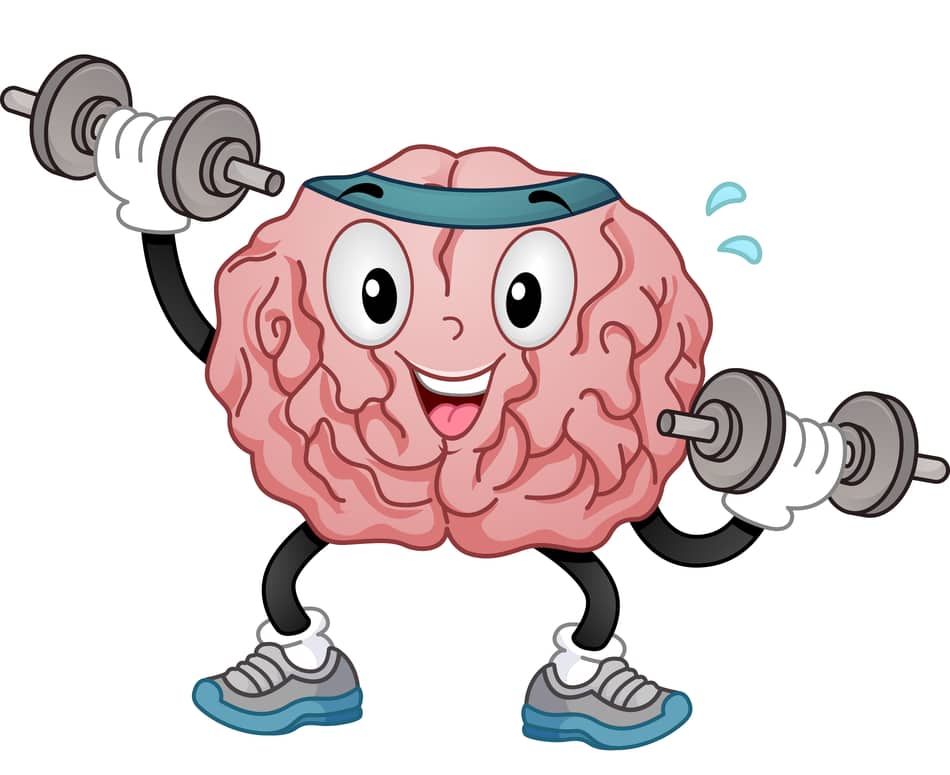
Mental training can also be known as psychological skills training (PST).
It is the process of preparing, coaching and refining an athlete’s mental skills.
So the focus is on developing cognitive flexibility (being able to think quickly), coping strategies for dealing with pressure, attentional control, confidence and decision-making to name a few.
Can a football coach use mental training?
Even though it would be beneficial to have an experienced sport psychologist to carry out this type of training, a coach can still use mental training techniques (PST) with some basic understanding of how it works.
What is psychological skills training (PST)?
- Imagery
- Goal setting
- Arousal regulation
- Concentration
- Self-confidence
So let us explore how you can practically use the distinct PST strategies.
Imagery
Have the player(s) sitting down comfortably with their eyes closed.
Talk to them through a particular scenario that you or they want to focus on, for example shooting.
Guide them with questions like the ones below::
- Picture yourself in a goal scoring situation
- Visually see yourself controlling and then striking the ball into the corner of the net.
- Imagine what that looks like
- What part of the foot (body) are you using?
- How do you feel as you are striking the ball?
The player can also think back to a goal they previously scored and think of what they did, how they were feeling etc.
By doing this, when a similar situation arises during a game, the player will already have a picture in their head of what they need to do and how to do it.
This is the link of the mind being connected with physical actions.
From a personal experience, I tried imagery with an U14’s team who were struggling to compete with other teams, due to rivals being physically and technically more advanced.
Before a game, against a team who had been scoring 5 goals or more on a regular basis, I implemented this imagery technique before the game.
Even though the players found it a bit strange, the performance (despite losing 1-0) was very pleasing, with parents making a number of positive comments after the game.
The focus of the imagery was on defensive positioning such as where they needed to be in various scenarios, in order to stop the opposition from having time and space in central areas.
Players seemed to be more focused and perhaps had a little more understanding of their positional responsibilities in relation to the position of the ball.
Whilst I realise that this is anecdotal and not clear evidence, there are studies that have found imagery to have a positive effect.
Goal setting
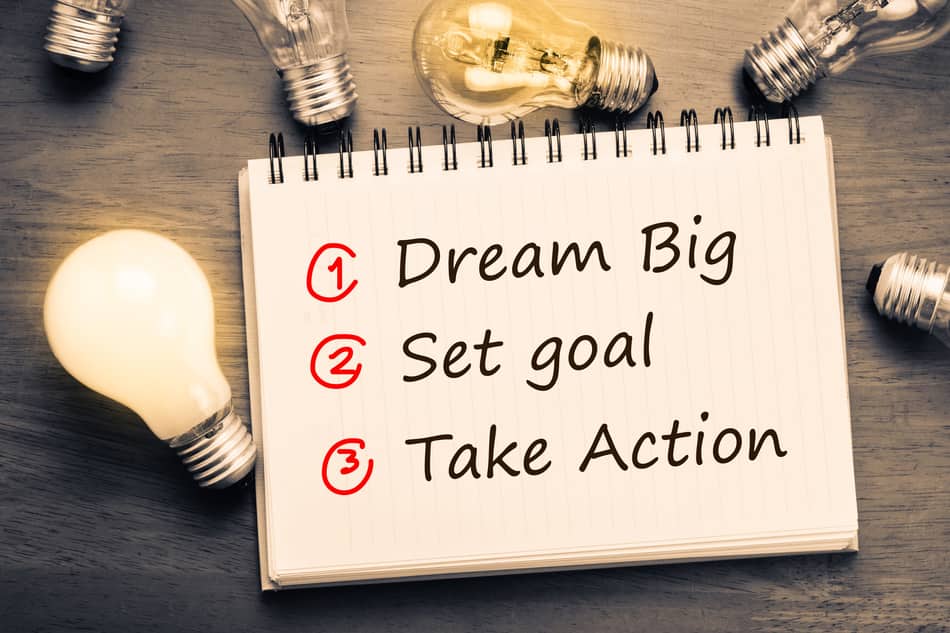
Creating a goal for a player to achieve is a great motivating tool.
It engages players to focus their mind and efforts in achieving a predetermined goal.
Goal setting can be applied with the whole team and on an individual basis.
Goal setting requires good communication and clarity on the goals set, as well as how these goals will be achieved.
To use the goal setting strategy for individuals, having one-to-one meetings with the player is the best way to employ this strategy.
While you can begin with an outcome goal, which might be to score 20 times by the end of the season, the following goals, for instance, performance and process goals are what is going to be needed to help the player reach the outcome goal.
Remember, an outcome goal is not solely under the control of the individual player.
It can be reliant on other factors such as the standard of the opposition and possibly refereeing decisions, to name a couple.
Goal examples:
Performance goal: To get 80 percent of shots at goal on target.
Process goal: Focussing on improving the technical proficiency of shooting.
Arousal regulation
Through a number of theories, such as drive theory and the inverted-U hypothesis to name just two, it has been hypothesised that the state of arousal can influence a player’s performance.
So it is important for players to have self-awareness of arousal levels.
For many athletes, high arousal levels can trigger anxiety which will in turn cause a negative impact on a performance.
For this reason, a coach must help them become aware of their emotions.
This can be done using a strategy recommended by Weinberg and Gould (2015)
The strategy uses a checklist (below) to record perceived performance levels alongside how the player felt at the time.
| Played extremely well | 1 2 3 4 5 6 | Played extremely poorly |
| Felt extremely relaxed | 1 2 3 4 5 6 | Felt extremely anxious |
| Felt extremely confident | 1 2 3 4 5 6 | Felt extremely unconfident |
| Felt in complete control | 1 2 3 4 5 6 | Had no control |
| Muscles were relaxed | 1 2 3 4 5 6 | Muscles were tense |
| Felt extremely energetic | 1 2 3 4 5 6 | Felt extremely fatigued |
| Self-talk was positive | 1 2 3 4 5 6 | Self-talk was negative |
| Felt extremely focused | 1 2 3 4 5 6 | Felt extremely unfocused |
| Felt effortless | 1 2 3 4 5 6 | Felt great effort |
| Had high energy | 1 2 3 4 5 6 | Had low energy |
Instructions: Using the first row as an example, if the player felt extremely confident then they would circle number 1.
If the player felt extremely anxious, then they would circle 6 and any number in between for less extreme scores.
“How individuals cope with anxiety is more important than how much anxiety they have”
Weinberg and Gould 2015
Once the player has completed the checklist, a coach can decide on what strategy to implement.
A couple of strategies, that studies have shown to have a positive correlation in reducing the psychological effects (anxiety) of arousal are:
- Progressive relaxation
- Breath control
Progressive relaxation
The basic principle of progresive relaxation is the athlete performs cycles of tensing and relaxing a variety of muscles.
The benefit to this technique is firstly, the consequence of doing this will relax the mind.
Secondly, a player will learn to know or be aware of when muscles are tense.
Due to the practice of progressive relaxation, when a player feels his or her muscles are tense, they will have experience of being able to relax the muscles.
Breath control
Whenever an individual is experiencing anxiety, their breathing can be erratic. If you ever concentrate on your breathing, you will notice that breathing in (and or holding your breath) tenses the muscles.
Tensed muscles can have a negative impact on an athlete’s movement, and therefore performance.
Players should learn how to focus on their breathing technique.
This is done through regulating each breath to be consistent, deep breath in and a slow release of the outward breath.
By bringing the mind back to focusing on breathing, this will disburse the amount of anxiety that the player might have been feeling.
It will also bring the players focus back to what they need to do and not concentrate on other distractions.
Just watch Ronaldo before he steps-up to take a free-kick.
Concentration
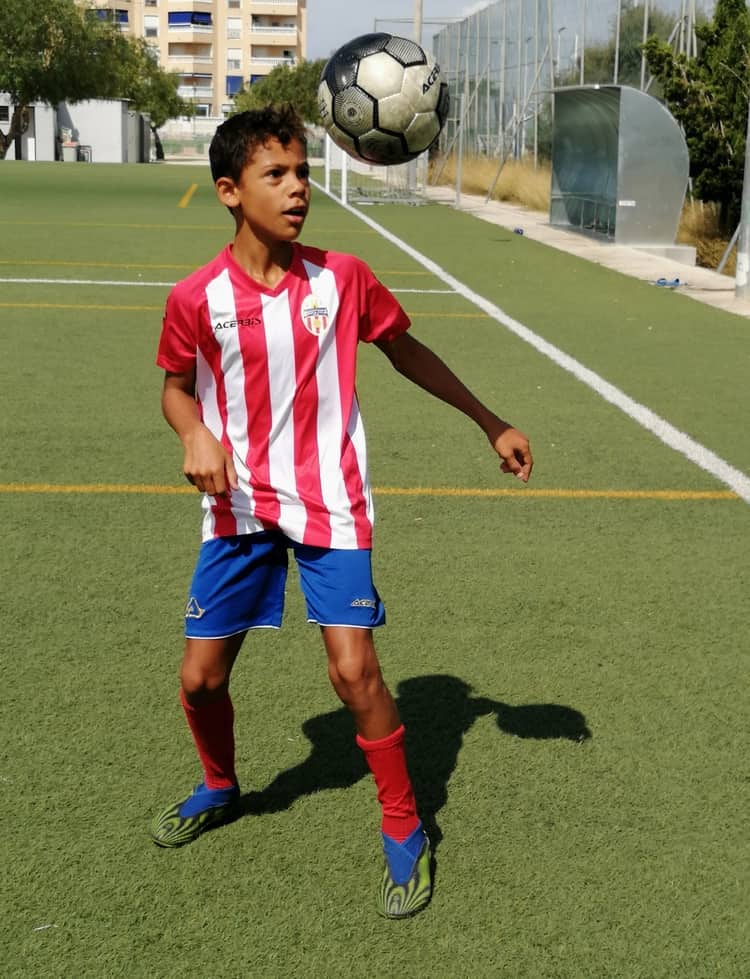
Concentration is the process of focusing on the most prevalent aspect of the game at any particular time.
I see a lack of concentration all the time amongst young players who try to dribble and or do tricks before they have the ball under control.
My advice to these players has been to fully focus on getting the ball under control, before attempting to dribble, execute a trick or shoot at goal.
When players fully focus on the most relevant task, their level of performance increases.
As players get older and their technical ability increases, for example, less concentration may be needed on a particular element of their game as it becomes more autonomo and therefore greater concentration can be given to a more complex task at the same time.
A coach can help a player do this through simple training practises where the individual learns to focus on one element of their game at a time.
Self-confidence enhancement
An athlete will at some stage have been through a period where they have felt low on confidence and nothing is going well or, in contrast, everything they do will be successful.
This state of mind can affect any player in a negative or positive sense.
And just like arousal, an athlete can have varying levels of confidence which can influence performance.
Too much confidence can lead to complacency and a lack of concentration
Too little confidence can lead to a player doubting themselves and as a result, they might start to overthink skills that would normally be done naturally and without much thought.
The consequence of this may be that their technique is not as good as what they are capable of.
So why, at lower levels of the game, is mental training not given the required time within a training week?
In the remainder of this blog we will look at some of those potential reasons that have been highlighted as an obstacle for implementing mental training…
and how we can overcome them.
WHY IS PST NEGLECTED?
Since there are many benefits to psychological skills training (PST), it may seem strange why PST is neglected by coaches.
The reasons given for this has been:
- Lack of knowledge
- Misunderstanding about psychological skills
- Lack of time
Lack of knowledge
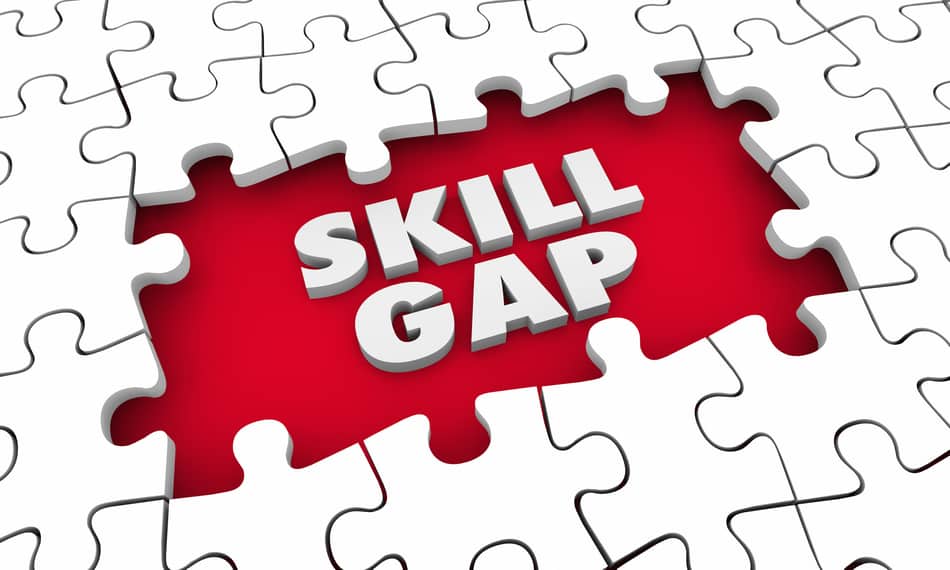
Teaching or coaching anything in which you do not have any amount of knowledge is not recommended.
This is why a lot of coaches tend to stay away from including psychological skills training within their practice.
It is also the reason why I wrote about this topic, so that other coaches might find it helpful
.
Asking a player to relax during a game might seem a pretty simple thing for someone to do, but the athlete in question may not know how to relax.
So a coach who has some knowledge of how to apply PST can step in and coach relaxation in specific sporting situations, during training, so that the player is capable of being relaxed during the game.
Misunderstanding about psychological skills
Generally all the great players and athletes in the world will share a common trait, such as mental toughness.
Yet none of them were simply given this mental toughness, but it was learned through specific practises which helped them achieve success.
I would imagine that the majority of coaches are aware of the mental traits of great players but often it is not perceived as something that has been learned but more as, either you have it or you don’t.
A coach will often say a player is mentally tough but the other other player is not, and yet the coach won’t even try to influence or attempt to improve the mental capacity of that player.
I have often heard coaches simply saying, you need to think more like Ronaldo or would Ronaldo give up?
The problem with that is Ronaldo has spent time practising on how to think in order to be mentally strong.
Lack of time
When you only coach a team for an hour, two times a week or maybe even once a week it is understandable that coaches find it difficult to fit mental training into the practice.
Many see the physical and tactical side so much more important than the psychological aspect.
However, think of the great Barcelona team under Pep Guardiola and the way they pressed teams to win the ball back quickly.
The midfielders of that team, Xavi and Iniesta, were not physically dominant but they were able to think quicker which helped them get to the ball almost instantly.
This was achieved through good cognitive behaviour patterns that were practised within training sessions.
INTEGRATING MENTAL TRAINING WITH PRACTICAL TRAINING SESSIONS
As I mentioned before, a lack of time can hamper the use of mental training.
So an alternative is to merge mental training within your practical sessions.
A study in Denmark, using players from professional clubs, done over an 18-month period, integrated PST into training sessions.
Before they began, the coaches were educated in the principles of mental skills and had an open meeting to develop or modify existing training drills that would be effective in challenging the players’ mental skills.
Example:
The aim of this drill was to place stress on the players whilst also provoking their self-talk capability.
This was achieved by explaining that if any element of the drill was not done to a good enough standard, i.e the weight of pass, control or the lack of quality with the cross, for example, then the drill would have to stop and start again from the beginning.
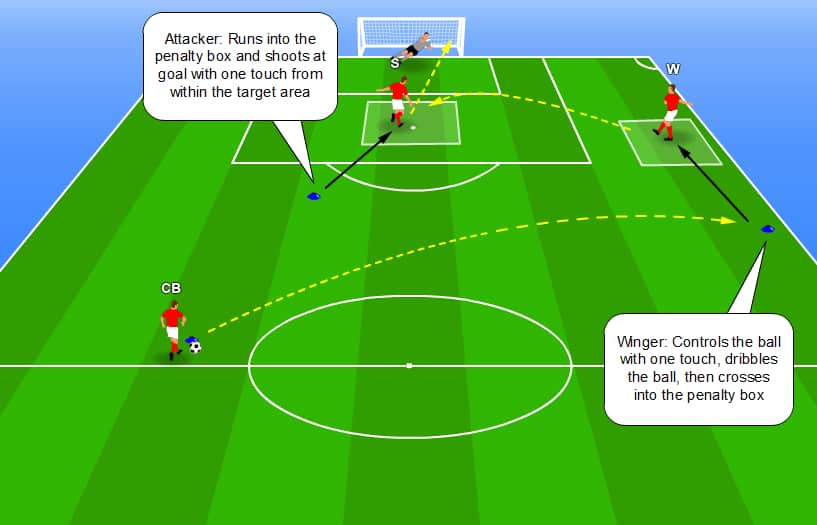
Description:
The central defender must execute a diagonal pass to the wide player, near the touchline.
The winger has to control the ball with a single touch, as they move forward.
He/she needs to travel with the ball at speed and then cross the ball to a predetermined space, inside the penalty area.
The attacker has to run into the predetermined space and attack the ball, shooting with one touch from within the square.
The drill consisted of four x5 minute rounds with each round involving players reviewing their self-talk and factors affecting their self-talk, whilst also evaluating their performance.
For those of you who are interested in the result of this experiment, in the main it was seen as successful.
Coaches commented on the practicality of the drills and being pertinent to the player’s mental development, whilst various coaches articulated a will to continue including PST type training with their team.
One club actually allocated one full training session a week to drills based on PST.
My aim for this article was to bring more awareness around the importance of mental training and how this can affect a player’s performance.
Also, to aid coaches who want to try and develop their ability to help players with the mental side of their game by…
- Providing some basic guidance on how mental training can be done
- Create an interest to explore and learn more about this topic
References:
Robert, S, Weinberg. and Daniel, Goud (2015) Foundations of Sport and Exercise Psychology, Human Kinetics
M, Voight. (2005) Integrating Mental-Skills Training into Everyday Coaching, Journal of Physical Education, Recreation & Dance
Check out another related blog post: What is a Sport Psychologist?
